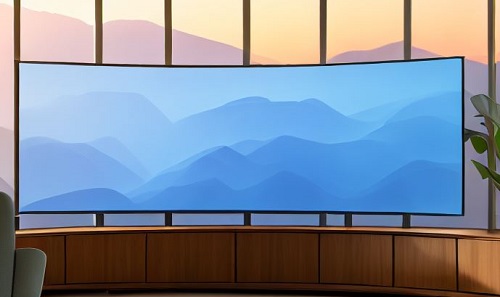Using your TV as a second monitor for your computer can be a great way to extend your workspace, watch content on a larger screen, or even play games. Whether you want to enhance productivity or enjoy a bigger display, this guide will walk you through setting up and using your TV as a second monitor.
Check Compatibility and Ports
Before you begin, ensure your TV and computer are compatible and equipped with the necessary ports. Here’s what you need to verify:
TV Compatibility
- Your TV should have an HDMI input port. HDMI is the most common and convenient way to connect a TV as a second monitor.
- Check the TV’s resolution and aspect ratio. Most modern HDTVs support at least 1080p resolution and a 16:9 aspect ratio, which is ideal for use as a computer monitor.
Computer Compatibility:
- Ensure that your computer has an available HDMI output port. This is typically found on laptops and desktops.
- Verify that your computer’s graphics card or integrated graphics supports dual monitors. Most modern computers should have this capability.
Acquire an HDMI Cable
You’ll need an HDMI cable to connect your computer to the TV. Make sure you have a cable of sufficient length to reach from your computer to the TV. HDMI cables are widely available and come in various sizes.
Power On Your TV and Computer
Before making any connections, ensure your TV and computer are powered on. This is important because both devices need to be active for the connection to be established correctly.
Connect the HDMI Cable
Now, let’s connect your computer to the TV using the HDMI cable:
Insert one HDMI cable end into your computer’s HDMI output port. This port is typically located on the back or side of your computer.
Insert the other end of the HDMI cable into one of the HDMI input ports on your TV. Remember which HDMI port you’ve connected to (e.g., HDMI 1, HDMI 2) because you’ll need to select that specific input source on your TV later.
Configure Display Settings
Once you’ve connected your computer to the TV, it’s time to configure the display settings to use the TV as a second monitor:
For Windows
Right-click on the desktop and select “Display settings.”
Scroll down to the “Multiple displays” section. You’ll have several options: – Duplicate: This mirrors your computer’s display on the TV, showing the same content on both screens. – Extend: This extends your computer’s desktop onto the TV, effectively giving you more screen real estate. – Second screen only: This displays content only on the TV, turning off your computer’s primary monitor.
Choose the display mode that suits your needs. You’ll most likely want to select “Extend” to use the TV as a second monitor.
You can also rearrange the displays by clicking and dragging the monitor icons in the “Display settings” window. This helps ensure the mouse cursor moves smoothly from one screen to another.
For macOS
Click the Apple menu and go to “System Preferences.”
Select “Displays.”
In the “Arrangement” tab, you’ll see a representation of your displays. Drag and arrange them to match your physical setup. You can adjust other display settings from this window, such as resolution and refresh rate.
Adjust Display Resolution (Optional)
Depending on your TV’s size and resolution, you may want to adjust the display resolution to ensure optimal readability and display quality:
For Windows
In the “Display settings,” scroll down and click on “Advanced display settings.”
Under “Resolution,” choose the resolution that matches your TV’s native resolution. This ensures the best image quality.
For macOS
In the “Displays” preferences, go to the “Display” tab.
Choose the appropriate resolution from the list of available options. macOS typically detects and sets the optimal resolution for your TV.
Set Up Audio Output (If Needed)
In addition to video, HDMI also supports audio transmission. If you want to use the TV’s speakers or audio system, you’ll need to configure audio settings:
For Windows
Right-click on the speaker icon in the taskbar and select “Open Sound settings.”
Under the “Output” section, select the TV or HDMI audio as the default playback device.
For macOS
In the “System Preferences,” go to “Sound.”
In the “Output” tab, choose the TV or HDMI audio as the output device.
Use Your TV as a Second Monitor
Once you’ve completed the setup and configuration, you can use your TV as a second monitor. You now have an extended desktop, which means you can drag Windows, applications, and content from your computer’s primary monitor to the TV screen.
Customize Display Preferences
To make the most of using your TV as a second monitor, consider these customization options:
- Display Arrangement: You can choose which side of your primary monitor the TV is placed on. This can be adjusted in the display settings.
- Scaling and Text Size: You can adjust text and app scaling to make content more readable on the TV screen. This can also be done in display settings.
- Wallpaper: You can set a different wallpaper for your TV screen, providing a visually distinct experience.
- Screen Savers: Customize screen savers to appear on the TV when not in use.
Disconnecting Your TV
When you’re finished using your TV as a second monitor, follow these steps to disconnect safely:
For Windows: – Right-click on the desktop and select “Display settings.” – Scroll down and click “Detect” under the “Multiple displays” section. – Select “Disconnect this display.”
For macOS: – Go to the “Displays” preferences and choose the “Arrangement” tab. – Uncheck the “Mirror Displays” option if it’s enabled.
Physically unplug the HDMI cable from both your computer and the TV.
Troubleshooting Common Issues
If you encounter any issues while using your TV as a second monitor, consider the following troubleshooting steps:
- Ensure your computer and the TV are powered on and connected correctly.
- Check the HDMI cable for any damage or loose connections. Try using a different HDMI cable if necessary.
- Ensure your computer’s graphics drivers are current, as outdated drivers can cause display problems.
- Ensure that you’ve selected the correct input source on the TV.
- Verify that your TV’s aspect ratio and resolution settings match your computer’s settings for the best display quality.
Conclusion
Using your TV as a second monitor can significantly enhance your computing experience, offering additional screen real estate for multitasking, entertainment, or presentations. Following the steps outlined in this guide and troubleshooting common issues, you can make the most of this setup and enjoy the benefits of a larger display.






